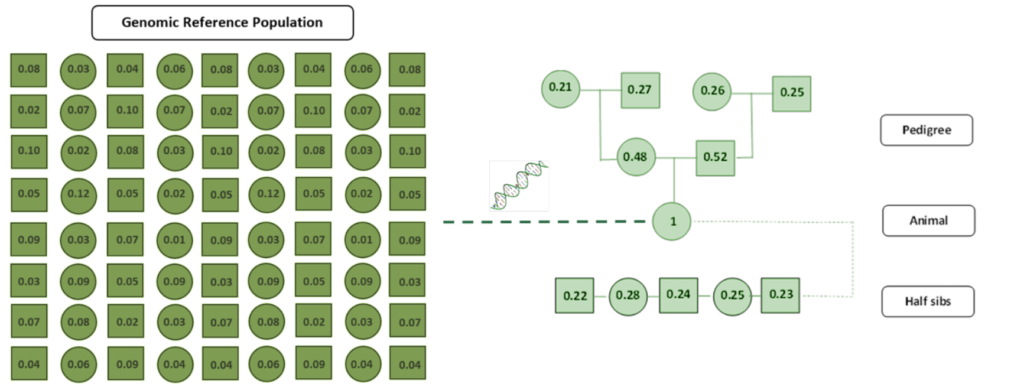Talking Genomics


How Are Genomically Enhanced Breeding Values Calculated?
Genomic selection in seedstock animals most commonly involves the inclusion of genomic profiles in existing industry genetic evaluations, such as the TransTasman Angus Cattle Evaluation, to calculate genomically enhanced breeding values.
Genomically enhanced breeding values enable more accurate selection decisions, earlier in an animal’s life, and for additional traits and animals, and ultimately, greater genetic improvement.
This edition of talking genomics discusses how genomic information is incorporated in the calculation of genomically enhanced breeding values within the TransTasman Angus Cattle Evaluation.
Single Step Genetic Evaluation
The manner in which genomic information is included in industry genetic evaluations is often referred to as a ‘single-step’ genetic evaluation, reflecting that genomic profiles are analysed simultaneously with other sources of information (e.g. pedigree, phenotypes), placing appropriate emphasis on all available sources of information, to calculate a single, genomically enhanced breeding value.
A unique feature of single-step genetic evaluation is that breeding values can be calculated for both animals with and animals without genomic profiles. This differs to some earlier approaches that could only handle individuals with genomic profiles.
Likewise, in contrast to some earlier approaches, a ‘genomic breeding value’ is not calculated in a single step genetic evaluation, only the overall, genomically enhanced breeding value that is published.

Analytical Approaches for Incorporating Genomic Information
There are a number of different analytical approaches for incorporating genomic information in the calculation of breeding values within a single-step genetic evaluation. The TransTasman Angus
Cattle Evaluation utilises a ‘relationship’ approach.
In the relationship approach, the incorporation of genomics is about ‘animal relationships’.
In a simplistic form, a breeding value is calculated by a) estimating the relationship between an animal and the other animals in the genetic evaluation, and b) using the performance information that has been collected for the animal and the animals to which it is related to predict an animal’s breeding value.
The more closely an animal with a phenotype is related to the target animal whose breeding value is of interest, the more influence that its performance has on the breeding value being calculated.
In traditional, pedigree based genetic evaluation, the relationships between animals are determined by pedigree alone.
In a genetic evaluation that incorporates genomics using the ‘relationship’ approach, the relationships between animals are determined by combining pedigree and genomic information.
Utilisation of genomic relationships, being the genetic relatedness between two animals based on their genomic profiles, improves estimation of the relationship between animals in the genetic evaluation, and ultimately results in the calculation of more reliable breeding values.

Genomic relationships enable:

Genomic Relationships in Practice
The real-world example below demonstrates how utilisation of genomic relationships improves the estimation of the relationship between animals in a single step genetic evaluation.
Based on pedigree information, Millah Murrah Paratrooper P15 would be estimated to have a relationship of 0.5 with each of his progeny. Similarly, his progeny would each be expected to have a relationship of 0.25 with one another.
Genomic testing reveals that while, on average, these relationships are correct, the relationship between Millah Murrah Paratrooper P15 and each of his individual progeny differs, while some of his progeny are more closely related to each other than they are with others.

Further Information
To further discuss the development of a genomic testing program for your livestock breeding program, contact staff at Neogen Australasia on +61 (7) 3736 2134, or visit our website, www.neogenaustralasia.com.au.
– Andrew Byrne, Senior Technical Product Specialist, Neogen Australasia